






 |
||||
 |
 |
 |
 |
 |
 |
||||
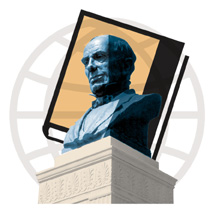
Wholly Hopkins Matters of note from around Johns Hopkins
Humanities:
For Hopkins sophomore April Anderson, a semester in
Washington meant a chance to peer into the future. "I
wanted to see where my major could take me in the real
world," she says.
A 20-hour-a-week internship this spring with
Transatlantic Magazine (a new endeavor by the
Nitze School of
Advanced International Studies) is helping her do just
that, with meaningful experience in writing, editing,
graphic design, and sales. She has written feature stories
about the Queen Mary 2 cruise ship, presidential
niece and model Lauren Bush, and George W. Bush and his
Democratic rival, Sen. John Kerry (D-Mass.). She has
solicited ads for the magazine, written press releases
about its launch, and brainstormed with designers about its
layout. The work has shown her exactly how valuable her
writing skills and her major in international studies
are. |
||
|
Janki Khatau at the Sackler Gallery Photo by Thomas Arledge |
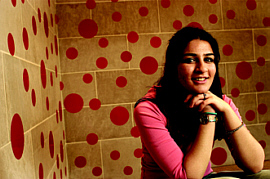 "Given all the hands-on experience and personal guidance
I'm getting, I think I might be-in the next five years or
so-in the position to set up a publication of my own," says
Anderson.
"Given all the hands-on experience and personal guidance
I'm getting, I think I might be-in the next five years or
so-in the position to set up a publication of my own," says
Anderson.That's just the kind of revelation that organizers of a new Krieger School program were hoping for. This semester, Anderson and several other undergraduates are the first to participate in the school's new Johns Hopkins Undergraduate Fellowship in the Humanities, living, studying, and working in the nation's capital. The program's mission, according to its associate director, Marcia Kupfer, is "to get students thinking about how they could apply their background in the liberal arts and humanities in a real-world setting."
Fellows (sophomores, juniors, and seniors are eligible to
apply and receive a stipend to offset expenses) live in a
University of California dormitory on Rhode Island Avenue,
a short walk from the Hopkins Washington Center on
Massachusetts Avenue. This spring's class numbers seven,
but school administrators hope to have as many as 15 in the
future. |
|
| The Library of Congress |
 The group spends a good deal of time in classes. One of the
three they take is essentially a cultural survey course of
Washington resources, in which they explore and evaluate
museums; attend a Kennedy Center play; and wander the
city's war memorials, gardens, and the Mall in search of
history, meaning, community, and memory.
The group spends a good deal of time in classes. One of the
three they take is essentially a cultural survey course of
Washington resources, in which they explore and evaluate
museums; attend a Kennedy Center play; and wander the
city's war memorials, gardens, and the Mall in search of
history, meaning, community, and memory.But, like the Aitchison Public Service Undergraduate Fellowship in Government, the school's other undergraduate residential study program (offered in the fall), the central feature of the humanities fellowship is the internship. Washington's plethora of cultural institutions and humanities-driven organizations provide students with plenty of opportunities. Sophomore Kyra Halperin, a Writing Seminars major, scours National Geographic magazines to develop pitches for programs in the company's television division. Two other fellows have internships at the Library of Congress; one of them, junior Rob Gamble, is compiling early 20th-century newspaper articles and writing essays for a Web site about their portrayal of such topics as military technology and propaganda. Another fellow works at the Atlantic Council of the United States, and another at a national organization for Chinese-Americans. Janki Khatau, a sophomore, works in the Smithsonian's Sackler Gallery, finding children's books on India and Pakistan in an effort to build a resource center on South Asia for teachers. The Writing Seminars major, who is also studying anthropology, says the opportunity has opened her eyes. "Before this semester, I felt like working in a museum would be really boring, but now I think I would like it," says Khatau. "Actually, I wish I could have my boss's job." — Angela Paik Schaeffer
Students:
Undergraduates at the Homewood campus will see a 4.9
percent increase in tuition next fall. Tuition for
2004-2005 will cost $30,140-$1,410 higher than this year.
The increase will apply to the more than 4,100 full-time
undergraduates in the Krieger School of Arts and Sciences
and the Whiting School of Engineering.
The board of trustees approved the new tuition charges at
its December 2003 meeting, along with next year's tuition
for all other full-time and part-time programs at Johns
Hopkins.
Andrew Douglas, interim dean of the Whiting School, says
that the recent series of conservative increases in tuition
have brought the university down to 10th place among its
peer group of 18 private research universities-the Ivy
League and such schools as MIT, Stanford, Duke, and
Georgetown-in total cost of attendance, which includes
tuition and room and board. (Hopkins' room and board for
2004-2005 is $9,516.)
"For the first time since the 2000-2001 academic year
Homewood undergraduates are being charged tuition and room
and board below the median of our peer group," Douglas
says. "That's an accomplishment that the trustees and
administration hope to extend and improve on."
To offset the high cost of attending Hopkins, the
university has been increasing the grant portion of
financial aid packages and reducing loans. This year 59
percent of Homewood undergraduates receive some form of
need-based aid, and 46 percent receive grants from the
university. Undergraduates who were members of the Class of
2003 graduated from Hopkins with an average student loan
debt of $13,300, well below the private college average of
$21,200. — Maria Blackburn
Research:
Artin Shoukas, professor of
biomedical
engineering, has devoted his expertise on the
cardiovascular system to studying the effects of long-term
space flight. After President George W. Bush proposed
funding a program to land humans on Mars, Hopkins
Magazine met with Shoukas to discuss some of the
potential physiological problems, especially
cardiovascular, encountered by astronauts who must spend
months in space. |
|
| Illustration by Brian Hubble |
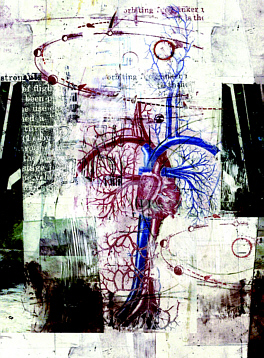 Johns Hopkins Magazine: What are among the principal
risks of long-term space flight?
Johns Hopkins Magazine: What are among the principal
risks of long-term space flight?Artin Shoukas: The first and most major risk is cardiac dysrhythmias, when the heart just beats very rapidly or in an erratic way, to the point where it's almost not pumping. There's a higher incidence, on the Russian Mir missions and on the International Space Station, of both reported events and also anecdotal information that we get from the astronauts. A significant number have experienced it in orbit. JHM: They feel their hearts just take off? AS: Yes. Either a pounding effect or slight flutter, that can range from a nuisance to the more debilitating effect of astronauts not being able to perform their function in space. JHM: What's next on your list? AS: The next risk we have to look at is orthostatic hypotension or orthostatic intolerance. When you stand up, there's an automatic reaction to constrict your veins in your legs, which pushes the blood back toward the heart and maintains your blood pressure [so you don't faint]. That normal occurrence is not needed in space because there's no gravity and blood doesn't pool in your legs. So in space the reflex is diminished almost to the point where it's non-existent. Is it a problem in space? No. It's a problem when you return to a gravity field. So if a person goes to Mars, and then has to move fast, say make an emergency egress, that may be a problem. [On] a long-term Mars mission, [it takes] approximately 270 days to get there. That's a long time to be up there. JHM: But astronauts do reacquire the ability to stand without difficulties. AS: Yes, but it may take anywhere from three days to a week. We do know that females suffer more from this.
JHM: Why? |
|
| "The most major risk is cardiac dysrhythmias, when the heart just beats very rapidly... to the point where it's almost not pumping," says Artin Shoukas. |
AS: We don't know. It could be estrogen. It could be
101 other things, and we're looking at them one at a time.
The third of the more critical risks is a degradation of
the ability of the heart to pump blood when it is needed.
This could be caused by two problems. It could be cardiac
muscle atrophy. Or it could be diminished effect of the
central nervous system on the myocardium itself-the brain's
function on the heart is diminished. JHM: Why would the brain's regulation of the heart be altered? AS: The exact mechanism-why it is occurring-is not known. What we're trying to find out at the molecular, cellular, and organ level is what is mechanistically happening. Why is this degradation going on? Once you know that, you can develop a countermeasure. That's what my business is about. JHM: What about radiation? AS: We know the immune system is degraded by radiation. What effect does the immune system have on the cardiovascular system? It has a drastic effect on it. What effect does radiation have on muscle atrophy? We have very little data. All of these things interplay with one another. It's not just the microgravity environment. It's everything you expose a person to on a long-term mission. JHM: Are any of these effects permanent? AS: In what we've seen so far, in all of the studies, anything in terms of the vasculature-cardiac dysrhythmias, cardiac atrophy, and the possible diminishment of the heart's ability to pump-does come back to normal function after the astronauts return, in three days to a week. — Dale Keiger
|
|
|
James and Lidia Wenz with their children, Adrianna and
James Jr., in March 2002 Photo courtesy of Norma Simonsen |
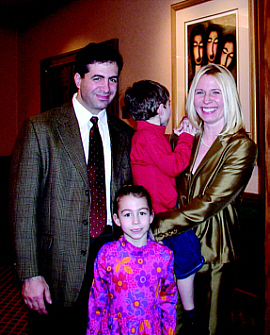 A Hopkins orthopaedic surgeon, James Wenz '91 (MD), 40, was
"the most brilliant innovator and technical surgeon ever to
graduate from the Johns Hopkins Orthopaedic Surgery
Residency Program," says Frank Frassica, chairman of the
Department of Orthopaedic Surgery.
"He will be tremendously missed not only by the Hopkins
community but also on a regional and national level. He was
a true gentleman and was universally loved by his patients,
colleagues, and friends."
A Hopkins orthopaedic surgeon, James Wenz '91 (MD), 40, was
"the most brilliant innovator and technical surgeon ever to
graduate from the Johns Hopkins Orthopaedic Surgery
Residency Program," says Frank Frassica, chairman of the
Department of Orthopaedic Surgery.
"He will be tremendously missed not only by the Hopkins
community but also on a regional and national level. He was
a true gentleman and was universally loved by his patients,
colleagues, and friends."Wenz concentrated on total hip and total knee replacement surgery, the treatment of osteonecrosis, the use of cartilage transplantation, and revision surgery for failed joint replacements. He was also interested in the care of fractures in geriatric patients. At the time of his death, Wenz was chairman of the Department of Orthopaedic Surgery at Johns Hopkins Bayview Medical Center, an assistant professor of orthopaedic surgery at the School of Medicine, and an attending surgeon at the Bayview Campus and the Johns Hopkins Hospital. Lidia Wenz, 44, a child psychiatrist, was an instructor in psychiatry at the School of Medicine. She had been a full-time member of the faculty before cutting back on her teaching in 2001 to spend more time with her children. "Lidia was as good as they come," says J. Raymond DePaulo Jr., director of the Department of Psychiatry. "She was one of the best adult residents in her years of training and then became a wonderful child psychiatrist. We all were planning her return to the full-time faculty when her children were older. She as well as her husband will be sorely missed." The unexpected death of two such talented individuals deprives the Hopkins community of far more than just their professional skills. "James Wenz was the personification of the spirit of Johns Hopkins Medicine," says L. Reuven Pasternak, vice dean for the Bayview Campus. "In all of [his] endeavors he was continually pushing the frontier with innovation. He did so with intelligence, wit, and most important, compassion." — Kay Downer
Libraries:
Cynthia Requardt sometimes answers the telephone and hears
singing. As curator of special collections at
Hopkins' Eisenhower
Library, part of her domain is the
Lester S.
Levy Collection of Sheet Music, an archive of more than
29,000 popular American songs from 1780 to 1960. People
sing to her hoping to find a song when they don't know or
don't remember its title or composer. What they do
remember, perhaps, is a lyric or two, or a snatch of
melody.
"People call up music librarians and hum a couple of
bars all the time," she says, smiling. "Were there a way to
search for melodies, that would be good."
Michael Droettboom is working on it. He's a scholarly
publishing specialist at the Sheridan Libraries Digital
Knowledge Center. One of the center's current projects is
developing optical music recognition software-code that
will enable a computer to examine a digital scan of sheet
music, recognize and extract the notation and lyrics, and
create computer files compiled in a database. An ideal
database could be searched for lyrics, or the occurrence of
specific words, or for melodies. People wouldn't have to
sing to a librarian anymore.
Droettboom studied computer music at Peabody, earning
a master's degree in 2002. He's building on work begun more
than 20 years ago by Ichiro Fujinaga, Peabody's associate
director of information technology. The software has been
long in development-and Droettboom has no idea when he'll
be finished-because optical music recognition is complex.
To produce an accurate scan of text, for example,
commercial optical character recognition software must
recognize about 62 characters: small and capital letters,
plus punctuation. Accurate scanning of music requires the
software to recognize about 200 symbols, Droettboom says,
plus understand how those symbols interrelate to create
musical meaning-pitch, volume, duration, etc.
Lyrics present another challenge. On sheet music, the
words to a song commonly are divided into syllables to
indicate their correspondence with the notes of the melody.
To create a useful database of lyrics, recognition software
has to understand how to recombine all the syllables into
the correct words. And it has to know that tempo marks like
andante are not part of the lyrics.
Sheet music in the Levy collection often contains
errors, Droettboom says, mistakes in transcription like
wrong notes or missing measures. A trained musician
recognizes errors and corrects them on the fly when playing
a song.
A computer doesn't know to do this, so another of
Droettboom's challenges is to teach the computer to think
like a musician, to recognize and correct errors. He'd like
for the code to create data files that can play the music
back on a computer, so the software has to be musical in
the same way a musician is musical.
One challenge was beyond Droettboom. He describes a
piece from the Levy archive that has little soldiers for
notes. He says, "We're not even going to try that one."
— DK
University:
Kumiki Gibson, former counsel to Al Gore, is excited to be
working in an educational setting. Says
Gibson, the university's new
vice president and general counsel, "I've always felt that
my calling in life was to improve the lives of others. It's
been clear to me that being the general counsel at a
university like this one is a way of doing that." |
|
|
Kumiki Gibson Photo by Will Kirk |
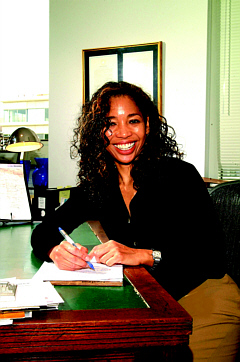 Gibson was an attorney with the Justice Department in 1992
and 1993 and in the White House during the Clinton
administration's first term, which is when she was counsel
to the vice president. Since 1997, she had been a partner
in the Washington law firm Williams & Connolly LLP.
Gibson was an attorney with the Justice Department in 1992
and 1993 and in the White House during the Clinton
administration's first term, which is when she was counsel
to the vice president. Since 1997, she had been a partner
in the Washington law firm Williams & Connolly LLP.Gibson, who is succeeding 28-year veteran Estelle A. Fishbein, and a staff of seven lawyers serve all of Hopkins except the hospital; their responsibilities include not only providing legal advice for all the departments and divisions, but also handling legal matters involving employees, resolving contract disputes, and ensuring Hopkins' compliance with outside agencies. "Ms. Gibson comes to us with a well-earned reputation as a bright and articulate advocate, a strategic thinker, a talented manager, and an engaging colleague," says Hopkins President William R. Brody. "Hopkins is a premier educational and research institution and one whose mission I support," says Gibson. "It's a mission that anyone can be proud of." — KD
|
|
|
The Great Fire of 1904 devastated 70 blocks of
Baltimore's downtown. Photo courtesy of the Enoch Pratt Free Library |
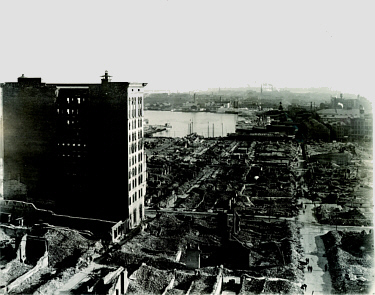 Collins, an administrative assistant at the Bloomberg School of Public Health, recently completed a bachelor's degree at Hopkins' School of Professional Studies in Business and Education. His emphasis was in history and historical research methods, and he wrote his senior thesis on business recovery after the Baltimore fire. His research unearthed what he believes was a long-forgotten victim of the blaze.
"I had gone through the state archives, looking for records
of what the state and city were paying to keep the militia
on duty after the fire," Collins says. "Something caught my
eye about a lawsuit, and I went to the newspapers to see if
there was something in the police blotter related to it. I
was very tired and it was very late, and I'd spent seven
hours going through Baltimore Sun microfilm. I'd
blown up a page from the 20th of February, and off in the
corner I saw 'Body of Colored Woman Found at Bowley's
Wharf.'" A few pages later, he found a second article in a
later edition of the paper, not much more than a column
inch in length; this one reported on the body of a "colored
person"-
the first edition had misidentified the gender-and stated,
"There appears to have been one death from the fire." |
|
| Photo courtesy of the Enoch Pratt Free Library |
 A badly burned corpse had been found in the wreckage of a wharf along what is now Baltimore's Inner Harbor. Collins did more investigating and found a death certificate for a male body that matched the newspaper's description. There was no record of where an autopsy had been performed. "But the body was disposed of at Hopkins [Hospital], which leads me to believe that the autopsy was done there," says Collins. After that brief notice in the Sun, there was no further mention in the newspapers, and the unidentified victim fell from the historical record. "There have been 30 to 35 people who [subsequently] have written about the fire, and everyone's overlooked that inch and a half," says Collins. "This was a black man who died in the fire, and the reason we don't know about it is because it was suppressed. It wasn't suppressed by a bunch of reporters who said, 'We found a body in the basin and we've got to cover this up.' What they would have said was, 'It's a black guy. Who cares?' It's an ugly thing to think, but I think it's true." — DK
Policy:
Telling young people to just say no to violence isn't
enough to stop the killing. In Baltimore, where the number
of people under 18 who were murdered jumped from 18 in 2001
to 33 in 2003, to reduce and prevent youth violence calls
for a multi-faceted approach that draws on everything from
targeted handgun patrols in high-violence areas to home
visits by nurses and intensive family therapy for at-risk
youths and their families.
Those are some of the recommendations made by Rachel Brash,
a graduate student in public policy at the
Johns Hopkins Institute
for Policy Studies (IPS). Her paper, "Youth Violence
Prevention and Reduction: Strategies for a Safer
Baltimore," in March won the Abell Foundation Award in
Urban Policy. The contest, sponsored by IPS and the Abell
Foundation, started last year. Open to all full-time
Hopkins students, it is intended to encourage fresh
thinking about the challenges facing Baltimore, according
to Sandra Newman, IPS director. As the winner, Brash was
awarded $5,000.
"Even beyond the numbers, there is a lot of crime and there
is a lot of fear," says Brash, noting that violence in the
city affects everything from housing prices to school
attendance. Now in her second year of the two-year master's
program, Brash says she'd like to work on implementing some
of the policies she outlined in her paper following her
graduation in May. "I would love to be involved with the
issue of youth violence prevention in Baltimore," she says.
"My ideal job would be as some sort of policy adviser with
the city." — MB
|
|
|
Future tycoons (from left) Erin Silverman, Aaron Ong,
Deanna Berchtenbreiter, Kelly Marshall, and Ebba Bonde with
economics professor Carl Christ. Photo by Bill McAllen |
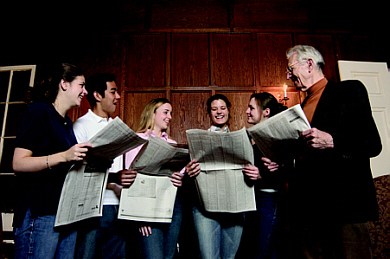 "Our intent and the intent of the donor is to give them a real responsibility," says John Wierman, a professor in the Whiting School of Engineering's Department of Applied Mathematics and Statistics and one of the team's three advisers. While other schools have similar funds, "they are almost all [part of] MBA programs," Wierman says. "This is fairly unique in being undergraduate and not limited to business majors." The first 5 percent in positive returns the fund makes each year gets put in an account for undergraduate scholarships. Anything above a 5 percent profit gets reinvested in the fund, Silverman says. At weekly meetings, the group's members listen to each other's investment pitches. "You have to sell the stock to the rest of the group," Silverman explains. They decide what to buy and sell by consensus. "I've learned a lot about working in a group," she adds. Silverman has also discovered an affinity for working in finance. When she started with the group as a freshman, she was considering a career in engineering. After she graduates next month, the history major from Boiceville, New York, will start a job on Wall Street as an analyst for Credit Suisse First Boston. And she'll have company. Says Silverman, "Almost every single member of the group who is a senior has a job on Wall Street." — MB
Anthropology:
Arriving at Johns Hopkins in 1997, Sonia Ryang expected to
find outspoken Asian American students. "When I came to the
U.S.," says the associate professor of
anthropology, "I
was hoping I would encounter a large wave of Asian American
power."
She was disappointed. "That was almost totally absent at
Hopkins," she says.
Over the last seven years Ryang has come to realize that
while the Asian population at Hopkins is substantial (17
percent of undergraduates are Asian), many of the students
are just too busy with school to be very active within
their community. Still, she wondered: "Why does there seem
to be such a dearth of interest in Asian Americanness on
campus?" |
|
|
Sonia Ryang Photo by Will Kirk |
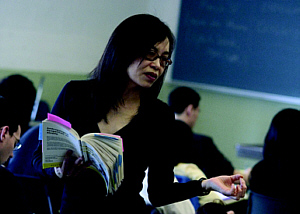 So Ryang, whose past research projects have focused on such
topics as the identity of Koreans in Japan and North
Korea's culture and ideology, decided to find out herself.
Last summer she embarked on a research project, called
"voice/life: asian american archives," to document the
Asian American experience by collecting stories.
So Ryang, whose past research projects have focused on such
topics as the identity of Koreans in Japan and North
Korea's culture and ideology, decided to find out herself.
Last summer she embarked on a research project, called
"voice/life: asian american archives," to document the
Asian American experience by collecting stories."I wanted to learn who these students are, where they come from, and how they see themselves. Are they purely American, or are they even interested in learning about their Asian heritage?" So far she's interviewed 20 students, all volunteers, about their backgrounds, their families, and their personal histories. Their diversity surprises even Ryang herself. "There is no way anyone can represent them in one blanket term," she says. "So far I have come across very, very different individuals. Some didn't place any emphasis on having Asian heritage, others are very aware. Some socialize only with other Asians, others don't place any boundaries. Some are bilingual, others speak only English." Ryang, who was born in Japan to Korean parents, received her PhD in social anthropology from the University of Cambridge in England and did postdoctoral research at Australian National University. She hopes to collect more stories over the next two years to round out her understanding of Asian Americans at Hopkins and beyond. Eventually, she plans to turn her research into a book. "I would like to do some historical and ethnographic research on Asian Americans in the Baltimore area," Ryang says. "Hopkins is my base to expand." — MB
|
|
| Gootiiz and Rees then... |
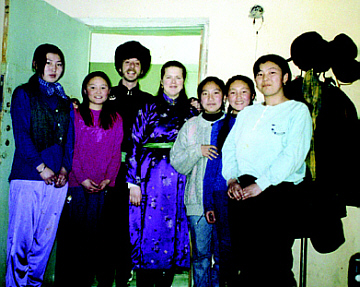 He thought she was bright. She thought he was tall. "We hit
it right off," says Rees, 34.
He thought she was bright. She thought he was tall. "We hit
it right off," says Rees, 34.But when Gootiiz headed off to the university in Mongolia's capital city of Ulaanbaatar and Rees left to work for a non-governmental organization in Guatemala, they lost touch. They didn't know if they'd ever see one another again. Years later and thousands of miles from Gootiiz' homeland, they reunited. The two met up while taking several of the same classes last fall at Hopkins' Nitze School of Advanced International Studies in Washington.
"It's pretty amazing," says Rees, who like Gootiiz is in
his first year of a two-year master's program focusing on
international development. "We sit and chuckle now and
again about living on the edge of the Gobi desert and
watching the dust storms roll by." |
|
|
... and now Photo by John Dean |
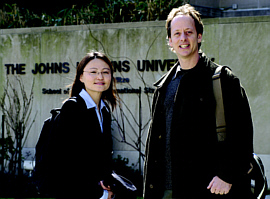 Gootiiz, 23, is from a rural family in a poor village.
While working as a translator for visiting foreign students
in Mongolia, she decided to study in the United States. She
was accepted at Cornell College in Mt. Vernon, Iowa, and
the college and surrounding community helped pay her way.
"People were really generous and really responsive," says
Gootiiz, who graduated from the college in 2002.
Gootiiz, 23, is from a rural family in a poor village.
While working as a translator for visiting foreign students
in Mongolia, she decided to study in the United States. She
was accepted at Cornell College in Mt. Vernon, Iowa, and
the college and surrounding community helped pay her way.
"People were really generous and really responsive," says
Gootiiz, who graduated from the college in 2002.She applied to SAIS to study international development. "I've always wanted to do something related to poverty," says Gootiiz, who has a fellowship from SAIS. "The voices of the people in developing areas should be heard." This semester, Gootiiz and Rees got together to celebrate Tsagaan Sar, the Mongolian Lunar New Year. "This is what the smallness of the world is all about," Rees says. — MB
Students:
Computer programming has yet to make an appearance on ESPN,
but it does have an international collegiate competition.
And for the first time, a team of Hopkins
computer students has
advanced from the regional qualification round to the
worldwide finals.
At press time, the Hopkins team-John Rittenhouse '05,
Shiroman Prakash '05, and James Plotts '04-were in Prague
vying with 72 other teams to be champions of
the 2004 ACM International Collegiate Programming Contest.
The 73 finalists were the victors in regional competitions
that drew teams from more than 1,300 institutions in 65
countries. Whichever team emerges as world champion will
win $10,000, a trophy cup, and global bragging rights.
Other top finishers will receive medals and cash prizes.
For those who have never attended a programming
championship: Each team receives eight or nine problems and
has five hours to write computer code that solves them. For
example, the 2001 world finals included a problem called
"Airport Configuration." Competitors had to write programs
that would devise the optimal traffic pattern for
passengers traversing a busy airport.
The team that solves the most problems wins, but speed
counts. If teams end up tied for the number of successful
solutions, the squad that programmed the fastest wins.
Rittenhouse laughs and acknowledges that the winning code
doesn't need to be elegant, it just has to work. He says,
"Most of the answers ... you wouldn't want to use them in
the real world." — DK |
 |
|
 The Johns Hopkins Magazine |
901 S. Bond St. | Suite 540 |
Baltimore, MD 21231
The Johns Hopkins Magazine |
901 S. Bond St. | Suite 540 |
Baltimore, MD 21231Phone 443-287-9900 | Fax 443-287-9898 | E-mail jhmagazine@jhu.edu |
|